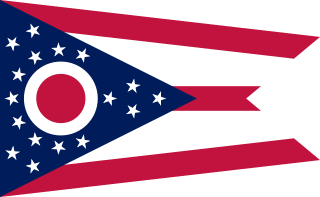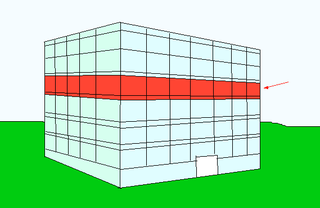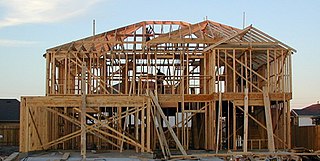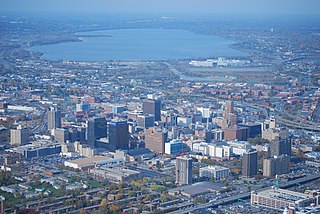
Downtown Syracuse is the economic center of Syracuse, New York, and Central New York, employing over 30,000 people, and housing over 3,600. It is also one of the 26 officially recognized neighborhoods of Syracuse.

The Saxony Apartment Building is a historic apartment building in Cincinnati, Ohio, United States. Located along Ninth Street in the city's downtown, this five-story brick building includes a distinctive range of architectural details. Among these elements are brick pilasters and projections, a three-story bay window on each side of the symmetrical main facade, semicircular balconies, and many stone pieces, such as pediments, keystones, and stringcourses. Due to its location at the intersection of Ninth and Race Streets, the Saxony appears to have two fronts: one onto each street. Although the Ninth Street facade is larger and more complex, the Race Street facade is nevertheless ornate as well: it features small yet elaborate semicircular balconies with wrought iron railings similar to those of the Ninth Street facade.

The Adgate Block was a historic building in Lima, Ohio, United States. Built in 1880, it was listed on the National Register of Historic Places in 1982 as part of the Lima Multiple Resource Area. The brick building was constructed in a combination of the Victorian and Romanesque Revival styles. During its history, the building was occupied by a series of businesses, including a pharmacy, a specialty store, and a pizzeria. Although the block has been destroyed and a new YMCA constructed on its place, it remains listed on the National Register.

The Armory–Latisona Building is a historic armory on South Main Street in Lima, Ohio, United States. Built in 1896, it features a Victorian variant of the Romanesque Revival style of architecture.

The United States Post Office in Lima, Ohio, United States is a historic Neoclassical building erected in 1930. Located along High Street west of the center of the city, the post office is one of the newest major buildings in the city's downtown.

The State Armory is a historic armory building at 29 Howard Street in Springfield, Massachusetts. Built in 1895, it is a prominent and distinctive example of Gothic architecture in the city's downtown. The building was the first that was purpose-built for the local militia, and was in its later years home to the South End Community Center. It was listed on the National Register of Historic Places in 1976. It was extensively damaged by the Greater Springfield tornado on June 1, 2011, in which the rear drill shed of the building was reduced to rubble.

The First National Bank and Trust Building is a historic building on Public Square in downtown Lima, Ohio, United States.

The Union Block is a historic business building on Public Square in downtown Lima, Ohio, United States. Built in 1878, it is a three-story brick building with a modified rectangular floor plan and a sloping roofline.

The Klaus Block is a historic building in downtown Lima, Ohio, United States. Built along Main Street in 1870, it is a rectangular three-story structure built in a Victorian variant of the Gothic Revival style of architecture. The exterior features a simple rectangular shape of three bays on each side, topped with a hip roof of asphalt. Decorations such as brick corbelling and stone trim highlight the interior.

The Linneman Building was a historic commercial building in Lima, Ohio, United States. Located along South Main Street in the city's downtown, it was built in a transitional style of architecture in 1899. A two-story structure, it was constructed of brick arranged in an artistic style. Among its leading architectural features was a pair of large semicircular windows in the center of the building's facade; each window was decorated with a sash of aluminum, and the building was crowned with detailed stone carvings done in the style of the works of Louis Sullivan. In 1982, the building's stonework was rated as being equal to that of the adjacent Dorsey Building and superior to that of all other buildings in the city.
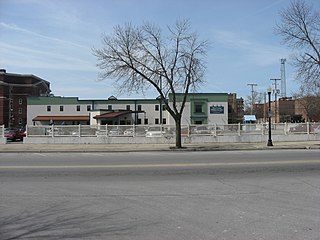
The Dorsey Building was a historic commercial building in Lima, Ohio, United States. Located along South Main Street in the city's downtown, it was built in a transitional style of architecture in 1899. Among its most distinguishing features was elaborate stonework, which was deemed equal to that of the adjacent Linneman Building and superior to that of all other Lima buildings. Like the Linneman Building and several other buildings on South Main, the Dorsey Building was constructed during a period of great prosperity in Lima: the railroad industry was expanding, and the discovery of petroleum in the vicinity had led to an economic boom in the city's economy.

The Beck and R.C. Cahill Buildings [sic] was a historic commercial building on the southern side of downtown Lima, Ohio, United States. Built in 1890 in a late version of the Victorian style, the building was located along Main Street south of the city's central square.

The Renz Block was a historic commercial building in downtown Lima, Ohio, United States. Located along North Main Street across from the Allen County Courthouse, the block was built in 1900 in a late variant of the Victorian style. A three-story building, the Renz Block was constructed primarily of brick with stone details; the roof was flat and made of asphalt. Among its leading aspects were an elaborate parapet and heavily decorated facade, including windows with doubly sashed transom lights.

The Martin and Kibby Blocks are a pair of historic buildings in downtown Lima, Ohio, United States. Erected in 1884, they are brick structures built in the Victorian Gothic style of architecture. Both buildings are rectangular structures, three-stories tall, and topped with sloped roofs of asphalt. Among the decorative elements present on these buildings are brick pilasters next to the main entrances, stone lintels around the windows, and decorative corbelling between the structural brackets.

The Ohio Theatre is a historic movie theater in downtown Lima, Ohio, United States. Built in 1927, the theater is a brick and concrete structure featuring multiple architectural styles. Outside, large amounts of terracotta details produce a Churrigueresque appearance, while Corinthian columns, marble and mosaic floors, and a massive chandelier produce an Italianate interior.

The Neely–Sieber House is a historic house on the west side of Lima, Ohio, United States. Designed by George S. Mills and built in 1904, the house combines elements of the Colonial Revival and Georgian architectural styles.

The Metropolitan Block is a historic commercial building along North Main Street in downtown Lima, Ohio, United States. Built in 1890 at the middle of Lima's petroleum boom, it is historically significant as a well-preserved example of Romanesque Revival architecture.
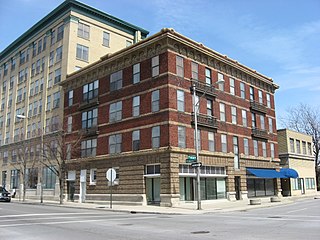
The Barr Hotel is a historic hotel on the eastern side of downtown Lima, Ohio, United States. Built in 1914, the Neoclassical hotel occupies the northeastern corner of the intersection of High and Union Streets.
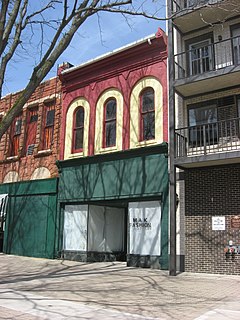
The Neal Clothing Building is the oldest existing building on the central square of Lima, Ohio, United States. Built before the end of the Civil War, it has been recognized as historically significant as a representative of the city's earliest period.
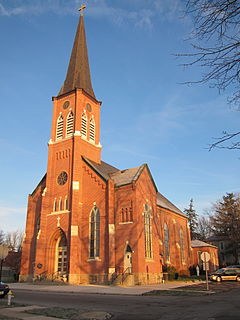
The North Main–North Detroit Street Historic District is a historic neighborhood on the northern side of the city of Kenton, Ohio, United States. Important because of its architecture and because of its prominent early residents, it was declared a historic district in 1985.

